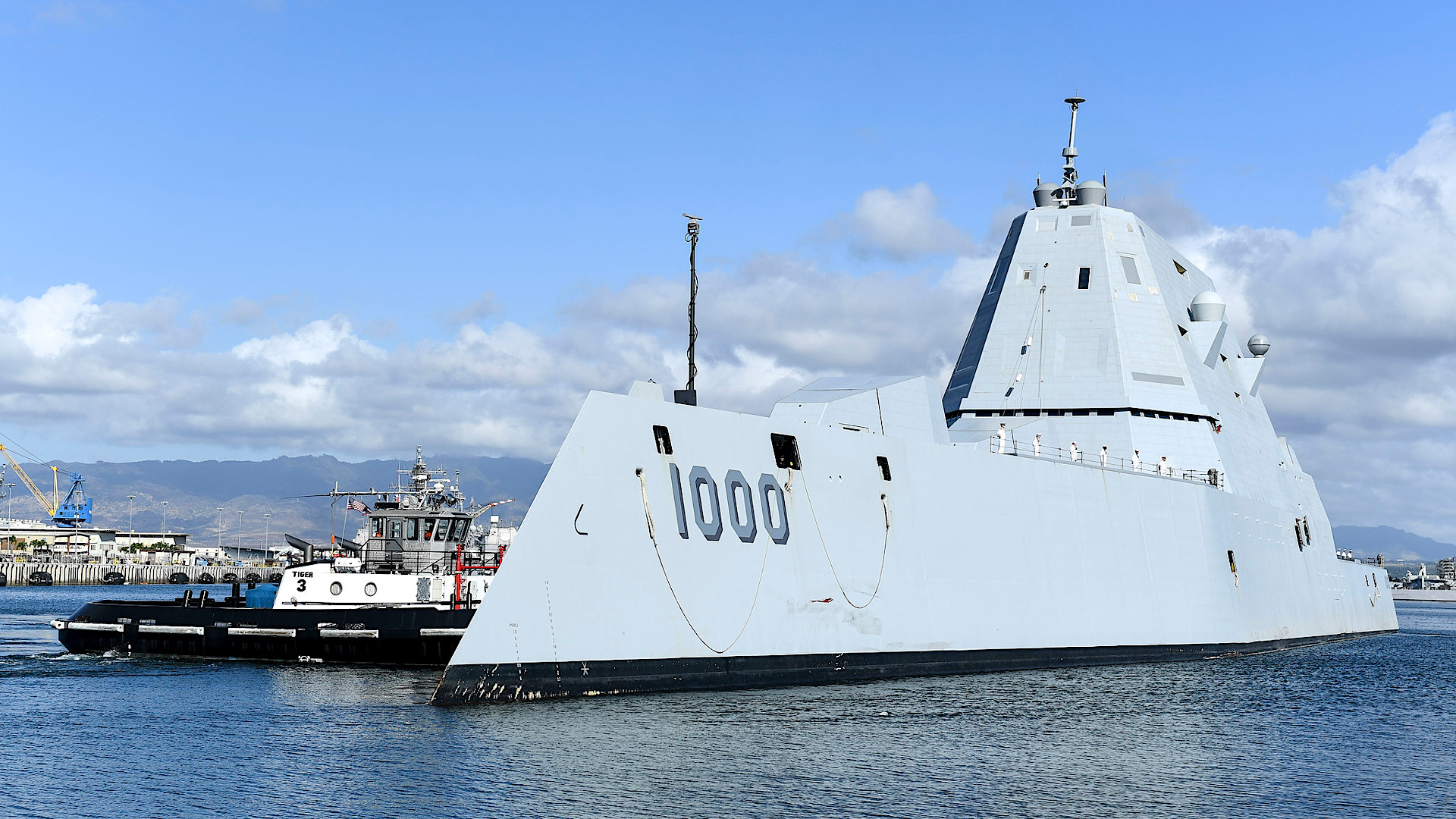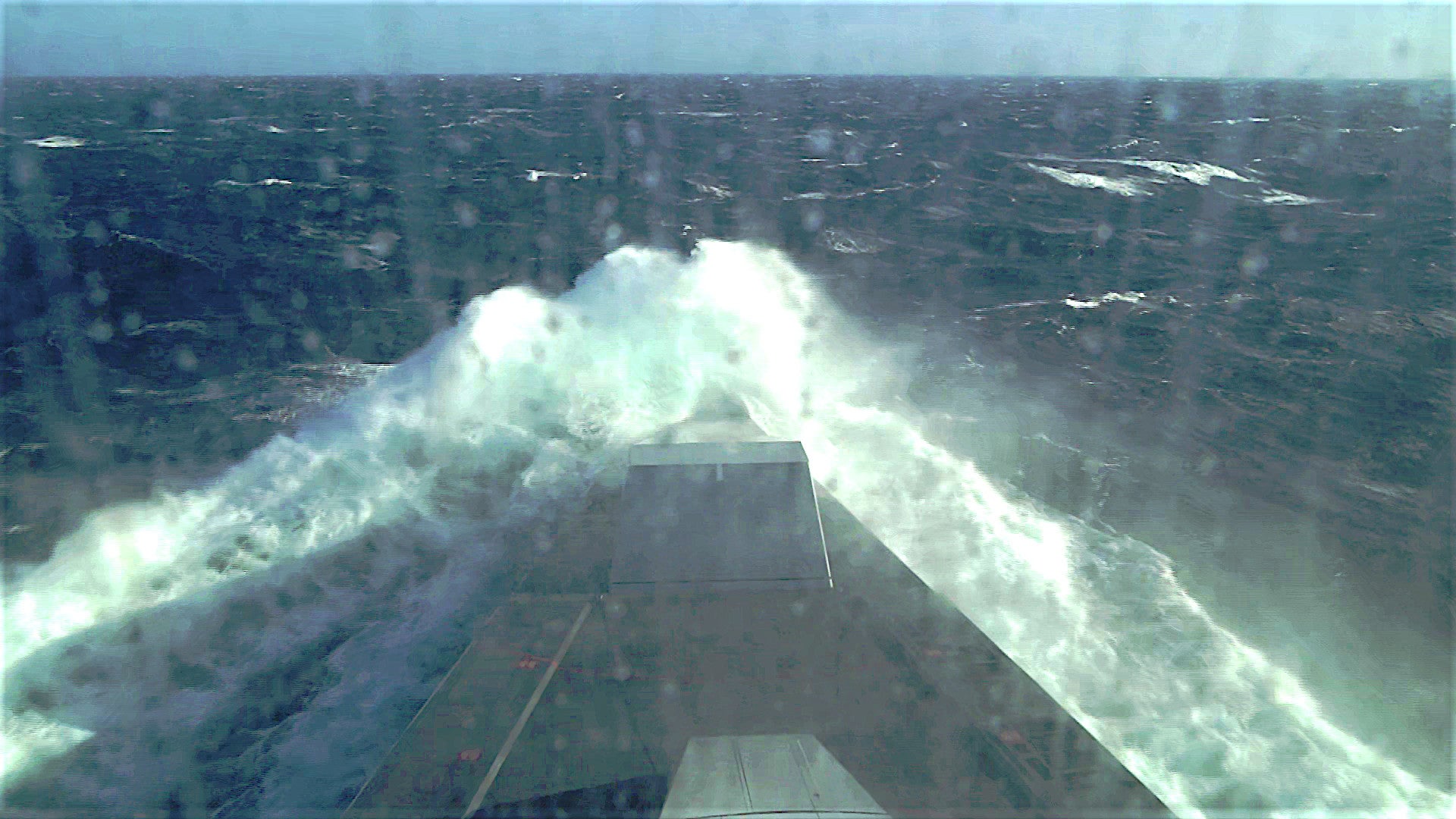The U.S. Navy says the stealth destroyer USS Zumwalt successfully completed the second and final phase of its Rough-Water Trials late last year. This involved sending the ship into two real-world storms with waves between around 16 and a half and 20 feet tall. The testing was extremely significant given the ship’s inward-sloping tumblehome hull form, which critics have long said would make it a disaster waiting to happen in heavy seas.
Defense News‘ David Larter was among the first to notice the official announcement about these trials, which took place between October and November 2020. The first storm Zumwalt, also known by its hull number, DDG-1000, sailed through, which had “mid-Sea State 6 wave conditions,” according to the Navy, was off the coast of San Francisco in Northern California. The second was near Ketchikan in the Alaskan panhandle and saw waves reach to the top-end of Sea State 6. The World Meteorological Organization‘s Sea State scale goes from 0 to 9 and Sea State 6, defined as “very rough seas,” covers instances where peak wave height is anywhere between 13 and 20 feet.

A team made up of personnel from the Naval Surface Warfare Centers at Carderock in Maryland and Philadelphia in Pennsylvania were responsible for evaluating the performance of the ship and its crew during these trials. This group had already overseen the first phase of the Rough-Water Trials in October 2019, which covered Sea States 2, 3, and 4, and focused on “the seakeeping behavior, structural response, and operability of DDG 1000 in mission-relevant conditions,” as well as “how the ship motion conditions affect crew performance.” Sea States 2, 3, and 4, range from waves just under 4 feet talk to those cresting at just over eight feet. This all followed earlier Calm-Water Trials off San Clemente Island near San Diego in Southern California.
While the Navy does run simulations and creates models of how it expects different ship types and their crews to hold up under different Sea States, there’s no substitute for the real thing. At the same time, the need to perform these trials when the wave conditions are just right can make scheduling difficult.
“We chose locations and times to conduct the testing that would correspond with what forecast models were indicating would provide the wave conditions required to complete our test matrix,” Stephen Minnich, the Rough-Sea Trials Director, said. “We deployed wave buoys that drifted on the sea surface, which helped us to quantify the seaway in terms of the wave height, period, and direction. We were completely at the mercy of Mother Nature during the testing, but those devices were critically important to the characterization of what we were seeing in terms of ship motion and structural response and for the situational awareness they provided to support safe execution of the testing.”
“Minnich and his team were encouraged by the results of the Rough-Water Trials, noting that there were no exceedances of critical motion criteria limits,” the Navy’s official news item on the at-sea testing added. The evaluation team is now preparing to recreate the trials in a model environment in Carderock’s Maneuvering and Seakeeping Basin, or MASK, a wave pool that holds 12 million gallons of water and is 240 feet wide and 360 feet long, seen in the video below. It will then be possible to see how that data compares to what was collected under real-world conditions. This process helps provide valuable feedback about the accuracy of the service’s modeling to help with future evaluations.

For Zumwalt, both the Rough-Water Trials and the Calm-Water Trials are part of a standard Performance and Special Trials (P&ST) program that the Navy conducts on the lead ship of every new class. As already noted, the trials were particularly important for this particular ship due to its hull design, over which has long raised concerns about stability in rough seas. “All told I’d rather be on that ship than any other ship I’ve been on,” Navy Captain Andrew Carlson, the destroyer’s commanding officer, had told Defense News in January 2020 while discussing taking the warship through Sea State 6 waters outside of formal trials the previous year.
“You definitely have to get used to the roll, which is very short compared to other ships,” Carlson added. “For those of us who have been on [Ticonderoga class] cruisers, especially up top, you kind of lean over 15 degrees and you wonder if you are going to come back. We didn’t experience any of that. As long as you get used to the finer oscillation, it really handles very well.”

The Ticonderogas also have notably high superstructures and are, all around, overloaded ships that have a maxed out hullform derived from the earlier Spruance class destroyer. This has left the cruisers with persistent cracking in their aluminum superstructures.
At the same time, the trials, though successful, are just another example of how much work there remains to be done to prove out the Zumwalt‘s most basic capabilities more than four years after it was officially commissioned. Even then, Congress had prohibited the Navy, by law, from formally accepting delivery of the ship until its core combat systems had been activated, which only occurred last April.
It was not until May 2020 that the destroyer fired one of its 30mm automatic cannons for the first time. It then conducted its first launch of an SM-2 surface-to-air missile five months later. All of this came after years of downgrading the ship’s capabilities and its stealthy signature, particularly through the addition of various external antennae.

There has been talk about adding new capabilities to the Zumwalt and her two sister ships, the USS Michael Monsoor and the future USS Lyndon B. Johnson, the latter two of which are in various stages of fitting out. These additions could include a new radar, as well as finally replacing the destroyer’s two ammoless 155mm main guns, a saga you read about more in this past War Zone piece.
No matter what, the Navy only expects to receive these three DDG-1000s, down from its original plans to acquire a fleet of 32 of these ships. The total program cost for the ships and the advanced technologies within them, at last check, was $26 billion. The trio has long looked set to have an, at best, limited operational utility, and they will all be assigned to Surface Development Squadron One, a unit primarily focused on testing and evaluating new systems, including unmanned platforms, and tactics, techniques, and procedures to go with them.
Still, Zumwalt has now proven its ability, and as a result that of the ships in its class, to make it through very rough seas, an important milestone that puts it one step closer to being able to carry out operational missions, no matter how limited, in more challenging environments.
Contact the author: joe@thedrive.com
